11 Best Native Plants for Chesapeake, VA
BY JEFFERY KEUSSEYAN | APRIL 16TH, 2023 | CHESAPEAKE, LANDSCAPING, VIRGINIALocated in the southwest of Coastal Plain, Chesapeake is blessed with a temperate climate where you can enjoy the outdoors all year round. Additionally, locals can feel at one with nature by taking long walks in the Chesapeake Arboretum. To get the exact same feeling on your very own property, you can transform your backyard by growing the best native plants for Chesapeake.
Native plant gardens are generally low-maintenance, water-efficient, and highly beneficial in supporting the wildlife habitat. However, it is important to note that not all Virginia-native plants thrive in the Chesapeake area. The following section will list some of the best plants for your native Chesapeake landscape, along with their characteristics.
- Flowering Dogwood
- Red Maple
- Eastern Redbud
- Cardinal Flower
- Winterberry
- American Witch Hazel
- American Beautyberry
- Black-Eyed Susan
- Red Chokeberry
- Common Buttonbush
- Southern Arrowwood
- How to Choose Native Plants for Your Chesapeake Landscape
- FAQ About Native Chesapeake Plants
- Where to Find Native Plants in Chesapeake
11 Best Native Plants for Chesapeake
Located in South Hampton Roads, Chesapeake lies in USDA Hardiness zones 7b and 8a. The temperature typically varies from 34 to 88 degrees Fahrenheit, with muggy summers and cold, windy winters. Chesapeake is not prone to prolonged periods of extreme weather, allowing a variety of plant species to thrive and help boost the local ecosystem.
1. Flowering Dogwood (Cornus Florida)
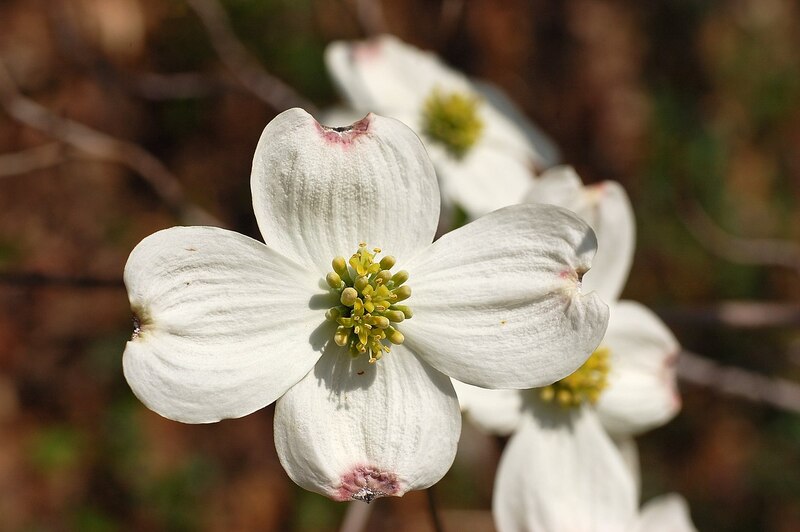
Photo Credit: Derek Ramsey / Wikimedia Commons / CC BY-SA 2.5
Flowering dogwood is a small deciduous tree that can also be grown as a large shrub. It is a popular landscape tree that is highly appreciated by many gardeners. Regarded as one of the best native trees, this plant’s blossoms give way to glistening orange-red fruits in the summer.
Flowering dogwood is a valuable source of nectar and pollen to the area’s wildlife, including a wide variety of birds and butterflies. With no routine pruning necessary, this species is a valuable and low-maintenance addition to your native plant garden.
Plant type: Tree
USDA Hardiness Zone: 5 to 9
Sun: Grows best in part shade but can tolerate full sun
Soil: organically rich, moist, acidic soil
Duration: Perennial
Fragrance: Slightly fragrant
Bloom time: March – June
Water needs: Medium
Mature height: 15 to 30 feet, sometimes reaching up to 40 feet
Maintenance: Low
2. Red Maple (Acer rubrum)
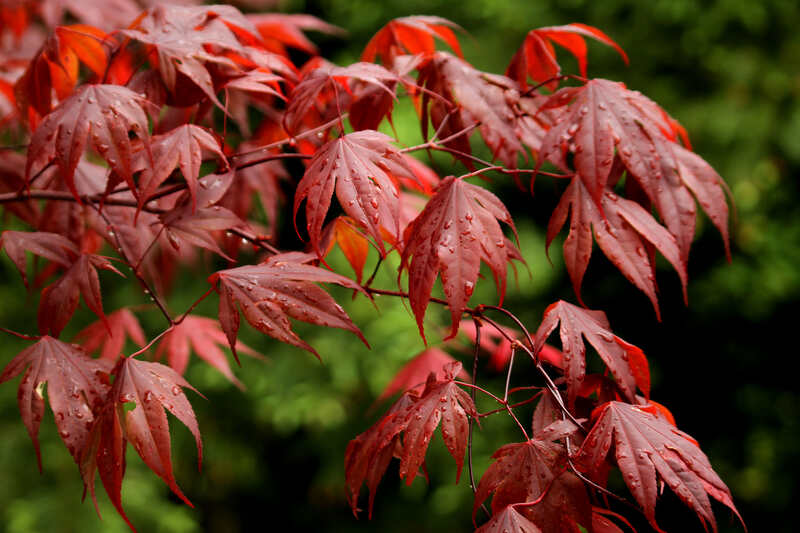
Photo Credit: Heng Wang / Wikimedia Commons / CC BY-SA 3.0
Red maple is an attractive, fast-growing deciduous tree that is quite popular among homeowners looking to revamp their backyard. In addition to its lovely fall color, it is just as attractive during the winter with its smooth gray bark. Tiny red flowers start to appear in early spring, followed by red fruits.
During the hot summer months, this tree will provide enough shade to help you enjoy those outdoor naps away from the sun. Red maple requires little pruning, though you may treat it with fertilizers before the leaves emerge. It is perfect as a specimen plant for lawns and roadsides.
Plant type: Tree
USDA Hardiness Zone: 3 to 9
Sun: Full sun, partial shade
Soil: Chalk, clay, loam, sand
Duration: Perennial
Fragrance: Sweet cherry or almond flower scent
Bloom time: March – April
Water needs: Average
Mature height: 40 to 70 feet
Potential hazards: Toxic to horses
Maintenance: Low
3. Eastern Redbud (Cercis canadensis)
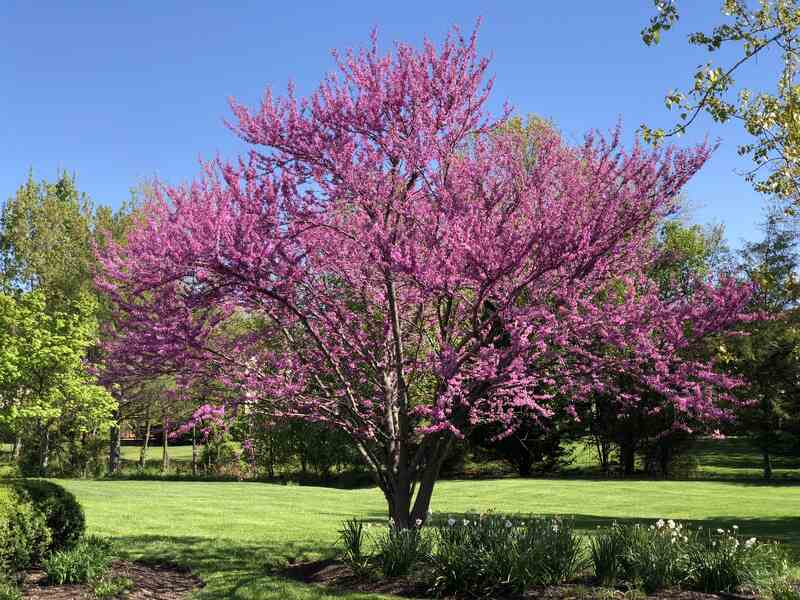
Photo Credit: Famartin / Wikimedia Commons / CC BY-SA 4.0
Eastern Redbud, also known as ‘Ace of Hearts’, is a deciduous tree with unique and irregular branching patterns. Reddish-purple flowers cover the bare branches in the spring. This tree has an attractive foliage of heart-shaped, dark green leaves that turn yellow in the fall.
Used for shrub borders or as a specimen plant, eastern redbud can provide your native garden with an elegant touch. More importantly, this tree attracts birds, butterflies, and bees.
Plant type: Tree
USDA Hardiness Zone: 4 to 9
Sun: Full sun or partial shade.
Soil: Any moist, well-draining, nutrient-rich soil
Duration: Perennial
Bloom time: Spring
Water needs: Keep the soil moist to a depth of 2 to 3 inches; watering schedule depends on your soil type, but you should water about once per week
Mature height: 20 to 30 feet tall with a 25 to 35 foot spread
Maintenance: Requires little pruning
4. Cardinal Flower (Lobelia cardinalis)
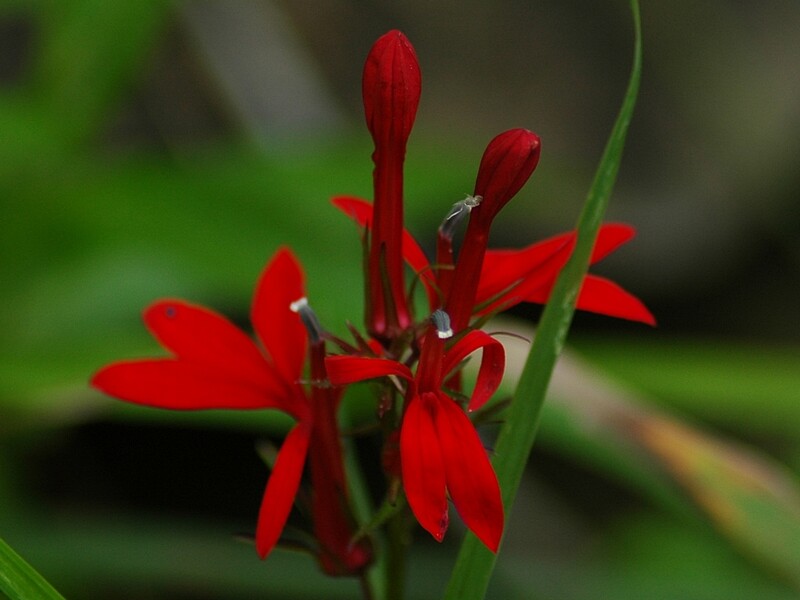
Photo Credit: linnaeus / Wikimedia Commons / CC BY 3.0
Cardinal flower is a magnet for beneficial insects, butterflies, and hummingbirds. From midsummer to early spring, this upright perennial boasts densely packed flower spikes with cardinal red, two-lipped blossom. It also has a foliage of glossy bright green leaves.
Not regarded as an invasive plant, the cardinal flower plant may self-seed in ideal growing conditions. It works great in butterfly, cottage, and rain gardens.
Plant type: Flower
USDA Hardiness Zone: 3 to 9
Sun: Full sun, partial shade, full shade
Soil: Sand, loam, clay, limestone-based
Duration: Perennial
Bloom time: May – October
Water needs: Medium to high
Mature height: 1 to 6 feet
Maintenance: Low
5. Winterberry (Ilex verticillata)
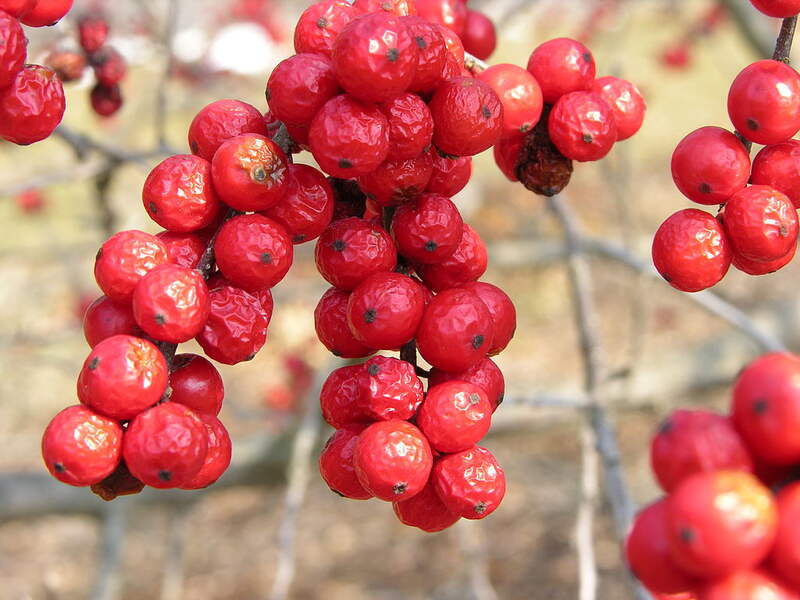
Photo Credit: Derek Ramsey / Wikimedia Commons / CC BY-SA 2.5
With a foliage of dark green leaves, winterberry is a slow-growing deciduous shrub that adds color to your winter landscape. It produces small, greenish-white flowers in late spring followed by cherry red berries. In order to get these berries, you will need to plant both a male and female shrub. The male plant must belong to the same species and bloom at the same time as the female.
Winterberry flowers have no scent, but are a great pollination source for bees and other beneficial insects. This native shrub is perfect for hedges or as a specimen plant.
Plant type: Shrub
USDA Hardiness Zone: 3 to 9
Sun: Full sun to partial shade
Soil: Clay, loam, sand, moist, acidic
Duration: Perennial
Bloom time: April – July
Water needs: Medium to high
Mature height: 3 to 15 feet
Potential hazard: Might be toxic if ingested
Maintenance: Low
6. American Witch Hazel (Hamamelis virginiana)
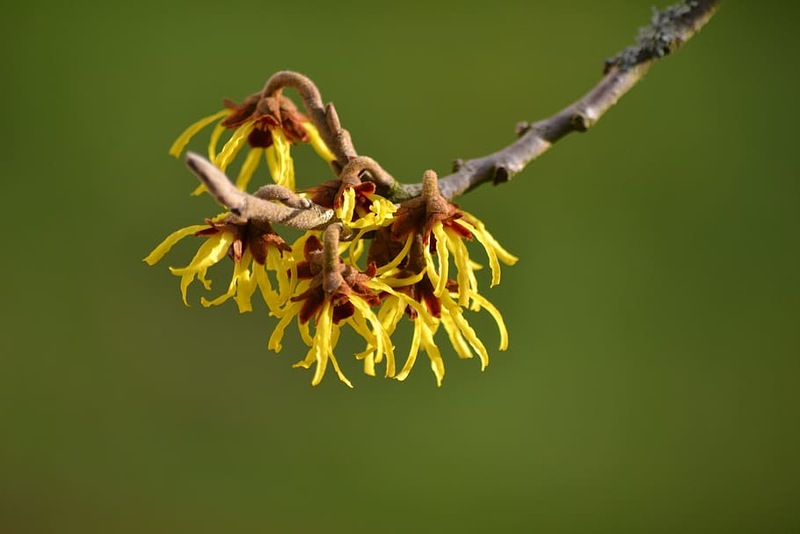
Photo Credit: Pxfuel
American witch hazel is a great addition to your native landscape. Planted as a deciduous shrub or small tree, it produces pale yellow flowers that bloom in fall and early winter. Each flower consists of 4 ribbon-like crinkled petals. The oval, light green leaves turn golden yellow for a colorful and aesthetically pleasing fall foliage.
As a fun fact, the American witch hazel is the species from which medicinal witch-hazel extract is made.
Plant type: Shrub, tree
USDA Hardiness Zone: 3 to 8
Sun: Full sun, partial shade, shade
Soil: Clay, loam, sand
Duration: Perennial
Fragrance: Sweetly scented
Bloom time: September to December
Water needs: Average
Mature height: 15 to 20 feet
Maintenance: Prune in spring to control its shape and size.
7. American Beautyberry (Callicarpa Americana)
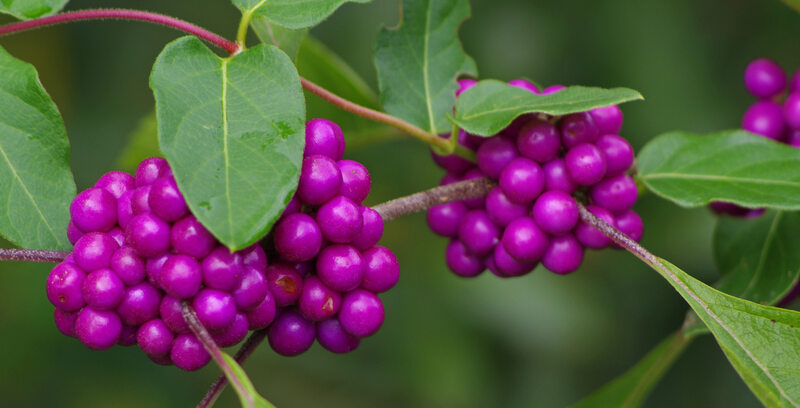
Photo Credit: Virginia State Parks staff / Wikimedia Commons / CC BY 2.0
Perfect as a specimen plant, American beautyberry is an easy-to-grow perennial with showy, magenta-colored fruits. These showy berries may persist even after the leaves have fallen. For the best possible fruit production, consider planting these shrubs in groups. As a bonus attribute, the American beautyberry is hurricane wind resistant.
Plant type: Shrub
USDA Hardiness Zone: 7to 11
Sun: Full sun to partial shade
Soil: Loam, Sand
Duration: Deciduous perennial
Fragrance: Citrus
Bloom time: Summer
Water needs: Low (one inch per week)
Mature height: 4 to 8 feet
Maintenance: Low
8. Black-Eyed Susan (Rudbeckia hirta)
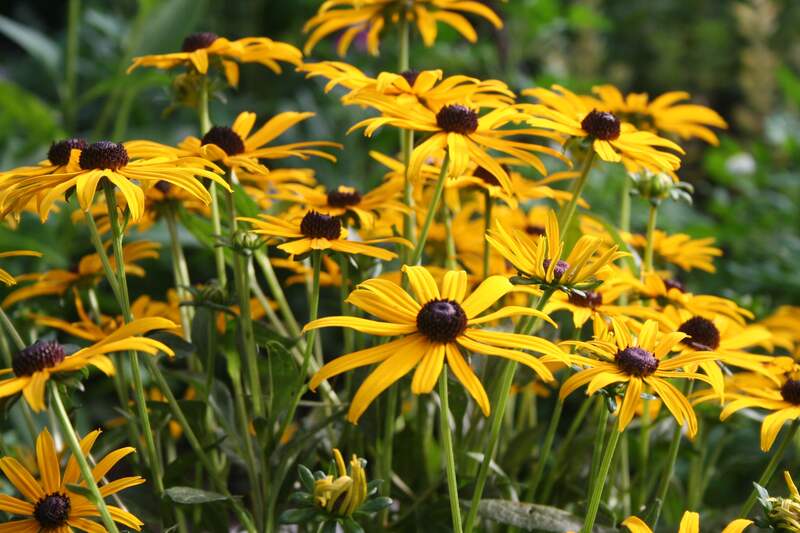
Photo Credit: Pxfuel
Black-eyed susan and purple coneflower come from the same plant family, but differ in their appearance and color. This native flower’s name is derived from the dark brown center of its daisy-like flower head.
Black-eyed Susan attracts butterflies, bees, and other pollinators due to the nectar found in its flowers. It is important to note that it can become aggressive if given too perfect an environment and insufficient competition. This native flower performs very well in landscapes, butterfly gardens, or as cut flowers.
Plant type: Flower
USDA Hardiness Zone: 3 to 9
Sun: Full sun
Soil: Clay, sand, loam, acidic, moist, well-drained
Duration: Depending on growing conditions can act as a biennial, annual, or short-lived perennial
Fragrance: Sweet
Bloom time: Spring, summer, early autumn
Water needs: Average (moderate drought tolerance)
Mature height: 1 to 3 feet
Maintenance: Low
9. Red Chokeberry (Aronia arbutifolia)
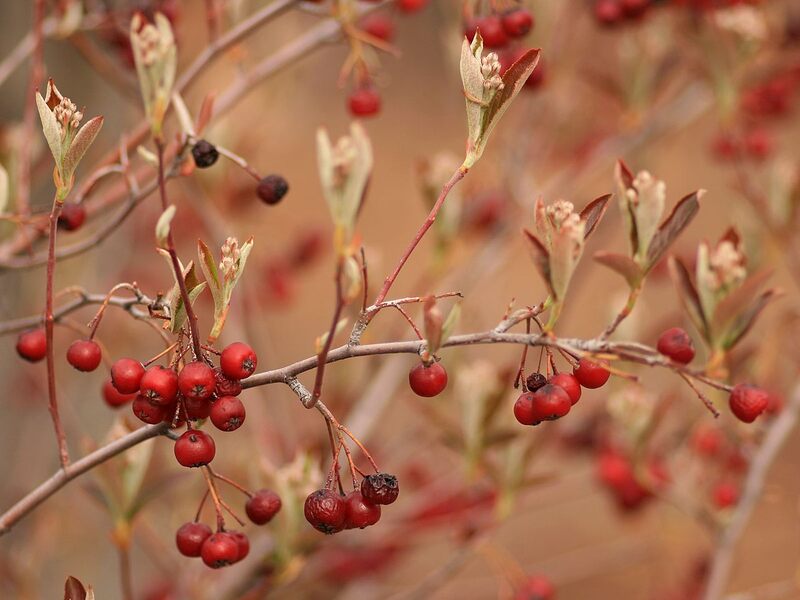
Photo Credit: Katja Schulz / Wikimedia Commons / CC BY 2.0
Red chokeberry is a tall, multi-stemmed shrub with a foliage of glossy dark green leaves that turn red in the fall. It produces white to light pink flower clusters along its branches. In late summer, these flowers are followed by red berries that persist well into winter.
Red chokeberry is an excellent addition to your native landscape with high wildlife value. It is a source of nectar and pollen to native bees and butterflies. Additionally, this plant’s fruits are an excellent food source for a variety of songbirds and migratory birds.
Plant type: Shrub
USDA Hardiness Zone: 4 to 9
Sun: Full sun, partial sun
Soil: Clay, loam
Duration: Perennial
Fragrance: Sweet-scented
Bloom time: February – May
Water needs: Average
Mature height: 5 to 10 feet
Maintenance: Low
10. Common Buttonbush (Cephalanthus occidentalis)
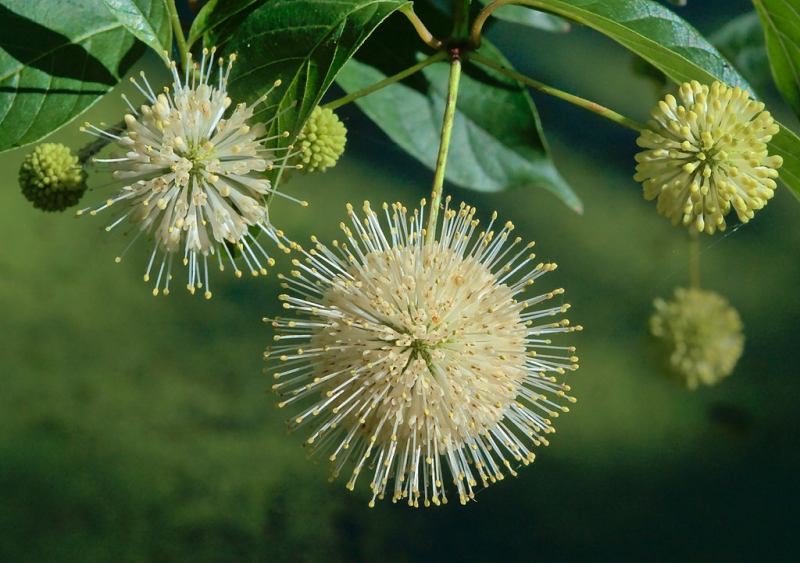
Photo Credit: The Cosmonaut / Wikimedia Commons / CC BY-SA 4.0
Common buttonbush is a multi-stemmed, deciduous shrub that boasts spherical flower heads from early summer to early fall. In addition to being a great plant to your native garden, this species is often used to restore wetlands, control erosion, and create wildlife habitats.
Common buttonbush attracts butterflies, hummingbirds, and other pollinators. It is perfect for rain and cottage gardens.
Plant type: Shrub
USDA Hardiness Zone: 5-11
Sun: Full sun, partial shade
Soil: Loam, sand
Duration: Perennial
Fragrance: Dried flowers and leaves smell like freshly-mown grass
Bloom time: June – September
Water needs: Average, high
Mature height: 5 to 12 feet
Maintenance: Low
11. Southern Arrowwood (Viburnum dentatum)

Photo Credit: David J. Stang / Wikimedia Commons / CC BY-SA 4.0
Southern arrowwood is a vigorous, deciduous shrub with creamy-white flowers that bloom from late spring to late summer. The flowers are followed by blue-black berries that are devoured by birds and small mammals. Additionally, southern arrowwood is very attractive to birds, butterflies, and native bees. This native plant is a must for bird gardens.
Plant type: Shrub
USDA Hardiness Zone: 2 to 8
Sun: Full sun, partial sun, shade
Soil: Clay, loam, sand
Duration: Perennial
Fragrance: Musty, unpleasant scent
Bloom time: May – July
Water needs: Average
Mature height: 6 to 10 feet
Maintenance: Low
How to Choose Native Plants for Your Chesapeake Landscape
As mentioned above, Chesapeake lies in USDA hardiness zones 7b and 8a. Though all of these plants are native to the area, not all of them might be suitable for your yard.
Before purchasing any of these native plants, you should double-check on your property’s soil type, exposure levels, and water availability as a starting point. Each of these factors can affect the plant’s growing ability in your backyard.
FAQ About Native Chesapeake Plants
Chesapeake has more miles of deepwater canals than any other American city. The larger Chesapeake Bay area and its rivers support a wide variety of underwater grasses.
Some of these aquatic plants include:
● Arrow Arum (Peltandra virginica)
● Eelgrass (Zostera marina)
● Horned Pondweed (Zannichellia palustris)
Just like every other city in the country, Chesapeake has a list of invasive species that homeowners and professional landscapers seek to avoid. Such invasive or non-native plants could prevent the native ones from thriving, and might even attract unwanted pests to or near your property.
Some of the invasive species in the area are:
● Phragmites
● Purple loosestrife
● Water chestnut
Did we need any more reasons to enjoy summer? Chesapeake nature lovers might already be aware of this, but the area is host to a bunch of native trees that produce sweet, edible berries. Searching for these wild berries is also a great way to spend time with your family and friends.
These are the 5 common edible berries in the Chesapeake area:
● Wild strawberries
● Red mulberry
● Serviceberry
● Raspberries
● Blueberries
Where to Find Native Plants in Chesapeake
The great thing about native plants is that they are not so hard to find. Plant species native to Chesapeake will grow naturally in forests, national parks, wetlands, and even near your own property.
Fortunately, there are several nurseries and garden centers that sell native plants to help with your backyard transformation. Not only do they sell plants, but they also have the knowledge to answer questions regarding native species and how to grow them properly.
Below are some local nurseries and native plant centers:
For more information on wildflowers, wildlife service, and native plant sales throughout the state of Virginia, visit the official webpage of the Virginia Native Plant Society.
If the backyard chores are taking up too much of your fun time, hire a local lawn care professional to handle the yard’s mowing, trimming, and edging.
Main Image Credit: Pxhere